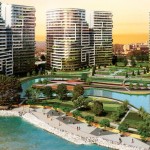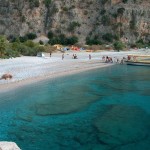Kayakoy
Kaya Village (Levissi): A Living Museum of Culture, History, and Hope
Nestled in the serene hills just a few kilometers from Fethiye, Kaya Village—historically known as Levissi—stands as a silent yet profound testament to the cultural fusion and historical transformations that have shaped the region over centuries. With roots dating back to the ancient city of Karmylassos, Kaya has witnessed the ebb and flow of civilizations, and today it remains a symbol of coexistence, resilience, and rebirth.
An Architectural and Cultural Time Capsule
Kaya Village is best known for its well-preserved architectural heritage, which spreads across the hillside in a naturally harmonious way. Hundreds of traditional stone houses, built in the typical Mediterranean style, line the narrow, winding streets—each constructed in such a manner that none blocks the sunlight of the other, exemplifying a thoughtful and sustainable approach to design. Alongside these homes, you’ll find the remains of churches, chapels, schools, workshops, and fountains, forming what can only be described as a unique architectural laboratory, offering deep insight into the daily lives of past inhabitants.
Legacy of the Population Exchange
The village as it stands today is deeply connected to the events following the Treaty of Lausanne (1923), when a compulsory population exchange was carried out between Greece and Turkey. The Greek Orthodox population that once lived in Kaya was relocated to Greece, and in their place, Muslim Turks from Western Thrace were resettled here. However, the Turkish newcomers struggled to adapt to the unique architecture, infrastructure, and agricultural practices of the region. Over time, this mismatch between environment and lifestyle led to a gradual abandonment of the village, turning it into a ghostly but evocative landscape.
A Village of Peace, Friendship, and Art
Despite its somber history, Kaya Village is not a place of sorrow—it is a place of healing and inspiration. Recognized today as an important cultural and historical site, the village is protected as a conservation area and is at the heart of various restoration and revitalization efforts. Both governmental and civil society initiatives are working to transform Kaya into a global model of peace, friendship, art, and sustainability.
Plans are in motion to establish a “Village of Friendship”, where the memory of past hardships is honored while creating space for cultural exchange, scientific inquiry, artistic expression, and ecological living. Festivals, workshops, and artist residencies are now regularly held in the village, breathing new life into its historic stones.
Local Crafts, Natural Products, and Rural Hospitality
Kaya Village is also famous for its Kaya Carpets, traditionally made using natural root dyes and authentic motifs that reflect the local culture. These carpets are cherished not only for their beauty but also for their symbolism—woven threads connecting past, present, and future.
Visitors can also enjoy locally grown figs, chickpeas, pomegranates, and melons, all cultivated in the fertile land around the village. Small family-run guesthouses, charming restaurants, boutique wineries, and the renowned Kaya Art Camp offer visitors a genuine taste of rural hospitality combined with creative energy.
Natural and Spiritual Attractions Nearby
Kaya’s surroundings are equally enchanting. Just a short distance away lies Gemiler Bay, a serene cove ideal for swimming and boating, believed to be the resting place of St. Nicholas (Santa Claus). Nearby, the Afkule Monastery, perched dramatically on a cliff, offers not only panoramic views of the sea but also a deep sense of spiritual solitude for those who make the scenic hike.
A Climate for Well-being
The mild and healthy Mediterranean climate in Kaya Village adds another dimension to its appeal. With clean air, unspoiled nature, and a peaceful pace of life, Kaya is ideal for those seeking physical and emotional well-being in a world that moves too fast.
Kaya Village is more than a historic site—it is a living, breathing space where cultures intersect, time stands still, and the future is shaped through memory and creativity. Whether you’re drawn by history, architecture, spirituality, or simply the desire to experience an authentic Turkish village, Kaya promises an unforgettable journey.











